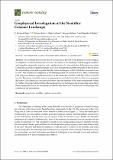Files in this item
Geophysical investigation of the Neolithic Calanais landscape
Item metadata
| dc.contributor.author | Bates, C. Richard | |
| dc.contributor.author | Bates, Martin | |
| dc.contributor.author | Gaffney, Chris | |
| dc.contributor.author | Gaffney, Vincent | |
| dc.contributor.author | Raub, Timothy David | |
| dc.date.accessioned | 2019-12-11T15:30:05Z | |
| dc.date.available | 2019-12-11T15:30:05Z | |
| dc.date.issued | 2019-12-11 | |
| dc.identifier | 264079718 | |
| dc.identifier | 9840527b-fba5-4e04-a53b-f95d2e35bf1e | |
| dc.identifier | 85077839662 | |
| dc.identifier | 000507333400089 | |
| dc.identifier.citation | Bates , C R , Bates , M , Gaffney , C , Gaffney , V & Raub , T D 2019 , ' Geophysical investigation of the Neolithic Calanais landscape ' , Remote Sensing , vol. 11 , no. 24 , 2975 . https://doi.org/10.3390/rs11242975 | en |
| dc.identifier.issn | 2072-4292 | |
| dc.identifier.other | ORCID: /0000-0001-9147-7151/work/66070502 | |
| dc.identifier.other | ORCID: /0000-0003-4513-2245/work/84315170 | |
| dc.identifier.uri | https://hdl.handle.net/10023/19121 | |
| dc.description | Funding: Scottish Enterprise | en |
| dc.description.abstract | The northern and western isles of Scotland have proved fertile ground for archaeological investigation over the last 100 years. However, the nature of the landscape with its rugged coastlines and irregular topography, together with rapid peat growth rates, make for challenging surveying. Commonly, an archaeological monument or series of monuments is identified but little is known about the surrounding areas and, in particular, the palaeo-landscapes within which the monuments are located. This situation is exemplified by the standing stones of Calanais in Lewis. Here, surrounding peat bogs have buried a significant portion of the landscape around which the stones were first erected. This project identifies remote sensing geophysical techniques that are effective in mapping the buried (lost) landscape and thus aid better contextualisation of the stone monuments within it. Further, the project demonstrates the most appropriate techniques for prospecting across these buried landscapes for as yet unidentified stone features associated with the lives of the people who constructed the monuments. | |
| dc.format.extent | 8652143 | |
| dc.language.iso | eng | |
| dc.relation.ispartof | Remote Sensing | en |
| dc.subject | Geophysics | en |
| dc.subject | Neolithic | en |
| dc.subject | Calanais | en |
| dc.subject | Stone circle | en |
| dc.subject | GF Human ecology. Anthropogeography | en |
| dc.subject | QC Physics | en |
| dc.subject | QE Geology | en |
| dc.subject | NDAS | en |
| dc.subject.lcc | GF | en |
| dc.subject.lcc | QC | en |
| dc.subject.lcc | QE | en |
| dc.title | Geophysical investigation of the Neolithic Calanais landscape | en |
| dc.type | Journal article | en |
| dc.contributor.institution | University of St Andrews. School of Earth & Environmental Sciences | en |
| dc.contributor.institution | University of St Andrews. Centre for Ancient Environmental Studies | en |
| dc.contributor.institution | University of St Andrews. Marine Alliance for Science & Technology Scotland | en |
| dc.contributor.institution | University of St Andrews. Scottish Oceans Institute | en |
| dc.contributor.institution | University of St Andrews. St Andrews Sustainability Institute | en |
| dc.contributor.institution | University of St Andrews. St Andrews Centre for Exoplanet Science | en |
| dc.identifier.doi | 10.3390/rs11242975 | |
| dc.description.status | Peer reviewed | en |
This item appears in the following Collection(s)
Items in the St Andrews Research Repository are protected by copyright, with all rights reserved, unless otherwise indicated.

